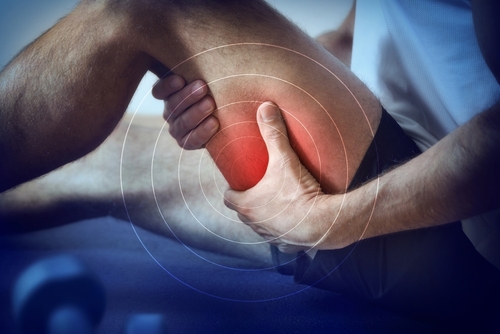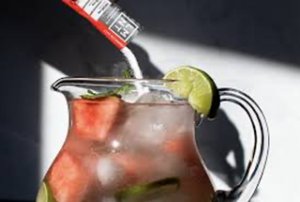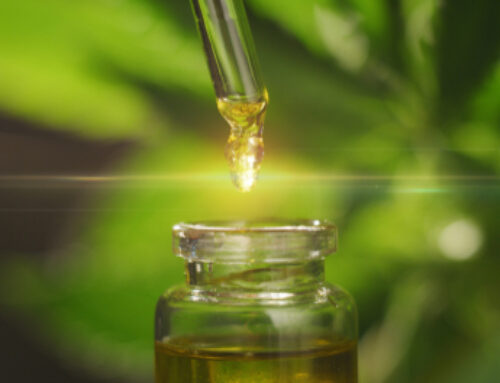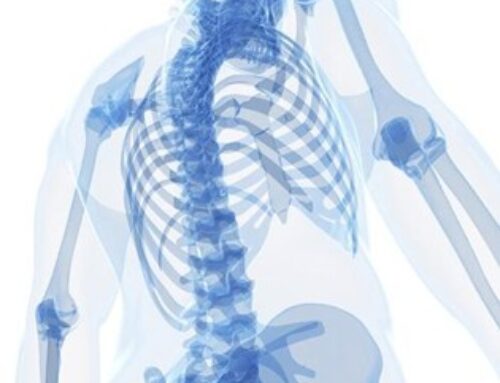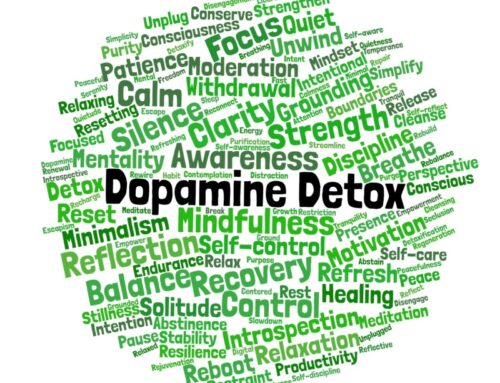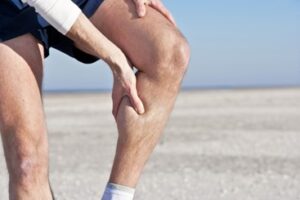 It is July and if you exercise during this hot month, you may experience painful muscle cramps. These excruciating, sustained muscle contractions are common with active people. Cramps are often associated with heat and are often called “heat cramps.” This can be misleading. It is not the heat that causes cramps directly; it is from an increase in sweating. When we sweat, we lose electrolytes through the skin, particularly sodium. This loss of sodium is what is the true cause of these types of cramps.
It is July and if you exercise during this hot month, you may experience painful muscle cramps. These excruciating, sustained muscle contractions are common with active people. Cramps are often associated with heat and are often called “heat cramps.” This can be misleading. It is not the heat that causes cramps directly; it is from an increase in sweating. When we sweat, we lose electrolytes through the skin, particularly sodium. This loss of sodium is what is the true cause of these types of cramps.
Because heat cramps usually result from sweating, they’re relatively easy to prevent. You can reduce exertion when it’s hot out, and replace fluids and electrolytes (especially sodium) when you sweat. In this post we will give you some great ideas on how to do both!
What Are Heat Cramps?
Besides painful muscle contractions, other heat cramp symptoms may include:
- Nausea
- Vomiting
- Fatigue
- Excessive sweating
- Weakness
- Rapid heartbeat
These symptoms don’t necessarily have the same cause as heat cramps (electrolyte deficiency due to sweating). Simply being outside too long in 100℉ or greater temperatures can cause heat exhaustion or heatstroke. Any condition of impaired thermoregulation can lead to a variety of complications. If you get hot enough for long enough, not even sweat can keep you cool.
Cramping can occur in both hot and cold environments. Whether on a cold day or a hot day, sweating can cause a loss of sodium. It is not clear that exertion alone causes muscle cramps. Sure, marathoners tend to cramp more towards the end of a race, but is that because they’re fatigued or low on sodium? I lean towards the latter explanation. They often have two forces pushing down their sodium levels:
- Loss of fluids and electrolytes through sweat
- Overhydration with plain water (which dilutes blood sodium levels)
That’s a formula for muscle cramps. I’m not dismissing the influence of fatigue, but I believe low sodium is the more significant driver. Officially, heat cramps are caused by electrolyte deficiencies in sodium, chloride, potassium, and magnesium. But, because sodium is the primary solute lost through sweat, it’ll remain my focus in this article.
A Brief Historical Reference
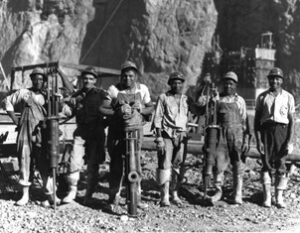 During sea voyages, a ship’s crew used to drink seawater to prevent heat cramps. Sounds tasty, right? During the Industrial Era, workers would often cramp working in hot factories or when performing strenuous activities. Workers would drink saline in England shipyards to prevent cramping. Laborers building the Hoover Dam learned quickly that adding salt to water would reduce cramping in their legs and hands. Harvard researchers were even asked to get involved. They found that the dam workers were symptom-free six hours after IV saline treatment. Steelworkers in the mills around Pittsburgh and Chicago would supplement with salt tablets to reduce their likelihood of cramps. The takeaway? Salt deficits have been cramping up humankind for a long time.
During sea voyages, a ship’s crew used to drink seawater to prevent heat cramps. Sounds tasty, right? During the Industrial Era, workers would often cramp working in hot factories or when performing strenuous activities. Workers would drink saline in England shipyards to prevent cramping. Laborers building the Hoover Dam learned quickly that adding salt to water would reduce cramping in their legs and hands. Harvard researchers were even asked to get involved. They found that the dam workers were symptom-free six hours after IV saline treatment. Steelworkers in the mills around Pittsburgh and Chicago would supplement with salt tablets to reduce their likelihood of cramps. The takeaway? Salt deficits have been cramping up humankind for a long time.
Athletics and Cramping
Any sport that induces sweating can induce heat cramps. Tennis players can lose 2.6 liters of water and 2.7 grams of sodium per hour. These losses interfere with muscle contraction since sodium regulates much of the nervous system. The government recommends a measly 2.3 grams of sodium per day. This pales in comparison to the requirements that an active tennis player needs during and after a match. Tennis players who consume salt (or sports drinks containing salt) at the first signs of muscle twitching can often reduce or stay cramp-free on the court.
College football players also sweat profusely during summer training. In one study, researchers split players into two groups: those who cramp frequently and those who cramp infrequently. Both groups lost around the same volume of sweat, but frequent crampers lost about twice as much sodium at 10.4 grams per day! The saltier the sweat, the more frequent the cramps.
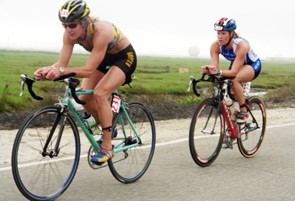 Evidence of sodium levels influencing cramping have also been seen with triathletes. These specialized endurance athletes show a greater frequency to cramp with an indirect relationship to the amount of sodium in their blood. For these athletes, making sure they have enough sodium in their bodies is key to optimal performance.
Evidence of sodium levels influencing cramping have also been seen with triathletes. These specialized endurance athletes show a greater frequency to cramp with an indirect relationship to the amount of sodium in their blood. For these athletes, making sure they have enough sodium in their bodies is key to optimal performance.
Consuming sodium at the onset and during athletic performance has been shown for many years to reduce and prevent cramping.
Keys To Preventing Heat Cramps:
Stay cool
When it’s hot or humid out, you sweat more. To reduce sweating and avoid heat cramps, do your best to stay cool. The cooler you are, the less your body needs to cool itself with sweat, the lower your risk for heat cramps.
Some practical steps include:
- Moving your golf match to a very early or late tee time
- Jogging in the early morning instead of the afternoon
- Working out in an air conditioned room
- Spraying yourself with a cool misting fan
- Wearing a wet towel around your neck when working outside
Hydration Steps
Most people think staying hydrated is synonymous with drinking water. This is not correct. If you only drink plain water, you’re neglecting the electrolytes that are crucial for energy production, mood regulation, immune health, and more. Sodium is especially essential to the hydration equation, but try not to neglect potassium or magnesium either. The solution doesn’t have to be complicated: just replace the sodium! Salt your food and drink electrolyte water on sweaty days. That’s it.
Supplement With Sodium
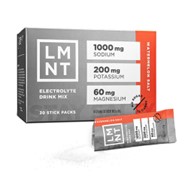 Supplements and vitamins can make living a healthier lifestyle easier. Supplementing with sodium is not any different. Sodium supplementation can greatly reduce heat cramps and improve your performance on the court or road.
Supplements and vitamins can make living a healthier lifestyle easier. Supplementing with sodium is not any different. Sodium supplementation can greatly reduce heat cramps and improve your performance on the court or road.
We are happy to be carrying a new sodium supplement called LMNT. LMNT was created to ensure people can hydrate healthily and conveniently. LMNT can be found in a powdered drink stick or as a can of sparkling seltzer. Each stick and can contains a great balance of all of the electrolytes needed to reduce or prevent cramping:
- 1000 mg sodium
- 200 mg potassium
- 60 mg magnesium
- Zero sugar, artificial flavors, or any other junk
Simply add one LMNT stick pack to 16-32 ounces of water to suit your taste, and drink when thirsty. The brand has been tested now by thousands of active people and the reviews are fantastic. If you are looking to have a little more fun with LMNT, we included a few fun recipes below.
Recipes:
- 1 stick pack of LMNt Watermelon Salt
- 16-32oz of soda water
- ½ cup cubed watermelon
- 2 slices of lime
- 1 tablespoon fresh mint, chopped
Directions: Mix everything in a pitcher and let sit overnight.
Cucumber Mint Refresher
- 1 stick pack LMNT Citrus Salt
- 16-32 oz of soda water
- ¼ cup sliced cucumber
- 1 tablespoon fresh mint, chopped
Directions: Mix everything in a pitcher and let sit overnight.
Blueberry Orange Smoothie
- 1 stick pack LMNT Orange Salt
- ½ cup frozen blueberries
- 1 scoop of Vanilla protein powder
- 1 scoop of ice
Directions: Mix all ingredients in a blender and enjoy.
Salty Gummies
- 2 sticks of your favorite LMNT packets
- 5 tbsp gelatin
- ¼ cup room temperature water
- 2 cups of boiling water
Directions:
Whip gelatin and LMNT with ¼ cup of water
Add boiling water and whip again
Pour mixture into candy molds and refrigerate overnight
Raspberry Keto Cookies
- 1 stick pack LMNT Raspberry Salt
- ½ cup Coconut oil
- 2 oz cacao butter
- ½ cup freeze dried raspberries
- optional (¼ cup swerve sugar replacement or Monk fruit sweetener)
Directions: Line a muffin pan with paper liners. Heat the coconut oil and butter over low heat until melted. Remove from heat. Grind the berries in a food processor until pulverized. Add the berries, LMNT, and the optional sweetener to the melted oil and butter. Pour evenly into the cups of the pan, chill for one hour or until firm.
Blueberry Orange Popsicles
- 1 stick pack LMNT Orange Salt
- 1 cup blueberries
- 1 can full fat coconut milk
- 1 tsp vanilla extract
Directions:
Blend all ingredients together. Pour into popsicle stand, mixing in whole blueberries randomly. Freeze for at least 4 hours.
We hope that you try these delicious recipes. Many more can be found on LMNT’s home website or at recipes.drinkLMNT.com. Let us know what are your favorites or if you have developed your own!

